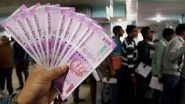Mumbai, November 3: Diwali is just round the corner and people have started preparing for the festival in earnest. Diwali: The festival of lights, is the biggest festival in India, marking the winter break and has a significant place in Indian culture. The festival has its roots in the Ramayana. According to a popular version, Ayodhya Vaasis (the residents of Ayodhya), celebrated the return of Lord Ram (after killing Ravan). For a long time, the festival has been associated with crackers, colours (rangoli), sweets and wearing new clothes. However, the recent Supreme Court order banning the sale of firecrackers (allowing only "green crackers" in Delhi NCR region) and restricting the bursting of crackers and setting a time limit for the same (8 pm to 10 pm), is a much needed effort in the direction of ensuring that the air quality does not suffer during Diwali. It is also an attempt by the top court to take back Diwali celebrations to its roots of making it eco-friendly. Diwali 2018: What Is The Story of Deepavali? Know The Significance, Myths and Legends of The Festival of Lights.
While some people may be disappointed at the time limit set by the Supreme Court for the bursting of the crackers, there are other ways through which people wanting to celebrate Diwali can adopt to ensure that the festival continues to be as 'cracking' as possible. After all, Diwali is much more about bursting crackers. Diwali Safety Tips 2018: Prevention and First Aid For Burns and Firecracker Accidents This Festive Season.
Below are the best eco-friendly ways through which people can celebrate Diwali
1. Saving Electricity Through Use of Diyas
Diwali is also about celebrating and saving electricity. The festival of lights also gives all of us the option to save electricity! Yes, difficult as it may sound, lighting is not all about using chinese electronics and fancy lighting equipments. The clay diyas, an integral part of the festival, can be lighted in large numbers as a substitute for the artificial lighting. Besides, buying them in large numbers will also help the indigenous industry.
2. Paper kandil
Paper kandil are a great way to curb plastic use and not just that. It also provides one the opportunity with preparing something creative and meaningful on their own. It may feel a bit overwhelming initially, but then it gives one the chance to try their hands back at what they learnt at school in craft classes.
3. Colors instead of techno- More Rangoli, less artificiality.
People insistent on new-age technology must remember, that in matters of festive celebrations, the best policy is to go old-school. People with kids can make the best use of this strategy and channelise the creativity of their kids to good use. Diwali is the festival of lights, and what better way can there be than to light up the atmosphere with colours. How about giving your the kids and yourself the task of creating rangoli and then throwing a party.
4. Less Use of Plastic
The less we use plastic, the better. The Maharashtra government has already banned use of plastic and people all over the country can help solve the problem of plastic use by finding substitutes. For example, using cloth or paper bags instead of plastic bags for carrying goods and shopping, can go a long way in creating awareness.
Diwali is celebrated across India and each culture has a distinct approach towards celebrating the festival. That may have to do with the complex history of Diwali and the countless myths and legends associated with it. However, all of us can do our bit to protect nature and yet celebrate the festival with all the fervour. The Indian way of life and celebrations have always been encouraging of promoting and celebrating festivals in harmony of nature. Keeping that in mind, here's wishing everyone an enthusiastic eco-friendly and safe Diwali.
(The above story first appeared on LatestLY on Nov 05, 2018 10:02 AM IST. For more news and updates on politics, world, sports, entertainment and lifestyle, log on to our website latestly.com).













 Quickly
Quickly


